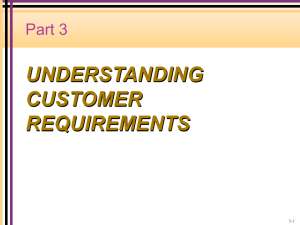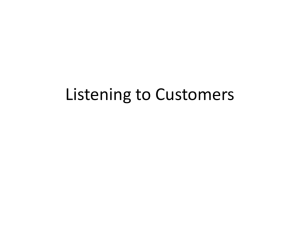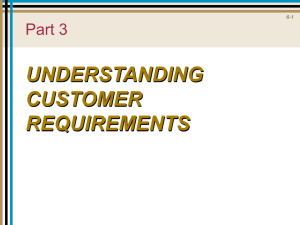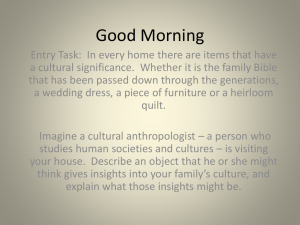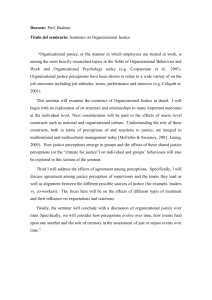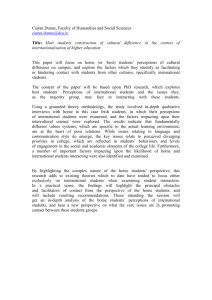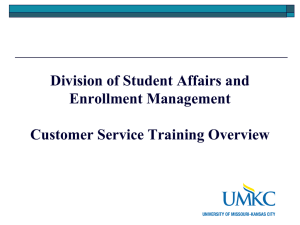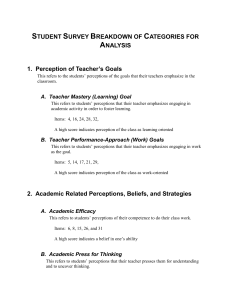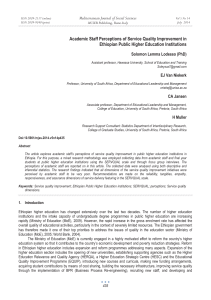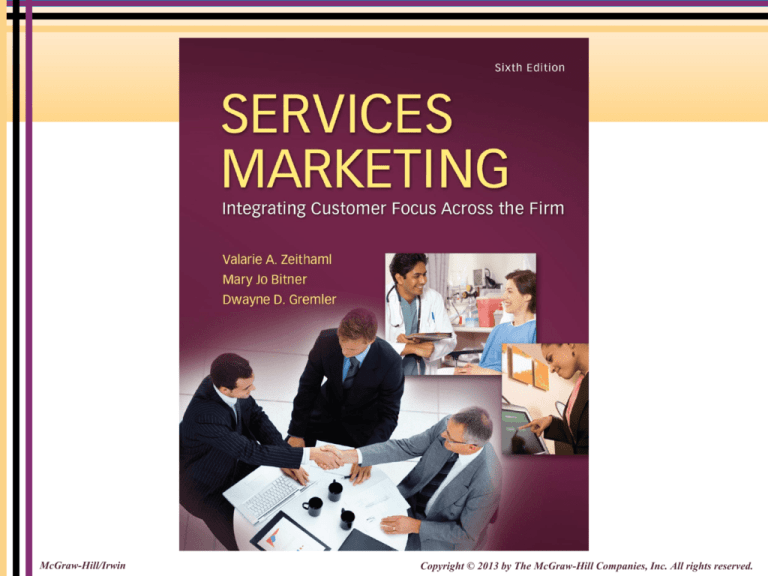
McGraw-Hill/Irwin
Copyright © 2013 by The McGraw-Hill Companies, Inc. All rights reserved.
Part 3
UNDERSTANDING
CUSTOMER
REQUIREMENTS
5-2
Provider Gap 1
CUSTOMER
Expected
Service
COMPANY
Gap 1:
The Listening Gap
Company
Perceptions of
Customer
Expectations
5-3
Key Factors Leading to Provider Gap 1
5-4
Chapter
Listening to Customers
through Research
5
Using Customer Research to Understand Customer
Expectations
Elements in an Effective Service Marketing Research
Program
Analyzing and Interpreting Customer Research Findings
Using Marketing Research Information
Upward Communication
5-5
Objectives for Chapter 5:
Listening to Customers through Research
Present the types of and guidelines for customer
research in services.
Show how customer research information can and
should be used for services.
Describe the strategies by which companies can
facilitate interaction and communication between
management and customers.
Present ways that companies can and do facilitate
interaction between contact people and management.
5-6
Common Research Objectives for Services
To discover customer requirements or expectations for service.
To monitor and track service performance.
To assess overall company performance compared with that of competition.
To assess gaps between customer expectations and perceptions.
To identify dissatisfied customers, so that service recovery can be attempted.
To gauge effectiveness of changes in service delivery.
To appraise the service performance of individuals and teams for evaluation,
recognition, and rewards.
To determine customer expectations for a new service.
To monitor changing customer expectations in an industry.
To forecast future expectations of customers.
5-7
Criteria for an Effective
Service Research Program
Includes both qualitative and quantitative research
Includes both expectations and perceptions of
customers
Balances the cost of the research and the value of the
information
Includes statistical validity when necessary
Measures priorities or importance of attributes
Occurs with appropriate frequency
Includes measures of loyalty, behavioral intentions, or
actual behavior
5-8
Portfolio of Services Research:
Research Is NOT Just Surveys!
Customer Complaint Solicitation
Critical Incident Studies
Requirements Research
Relationship and SERVQUAL Surveys
Trailer Calls or Post transaction Surveys
Service Expectations Meetings and Reviews
Process Checkpoint Evaluations
Mystery Shopping
Customer Panels
Lost Customer Research
Future Expectations Research
5-9
Common means for answering questions
Ask customers directly
mail, phone, face-to-face, online
one-on-one, in groups, formal/informal
Observing customers
anthropological tools, qualitative depth
Get information from employees and front line service
providers
Database marketing research
use customer information files
“capture” behavior through data analysis
5-10
Elements in an Effective Customer
Research Program for Services
Complaint
solicitation
• To identify and attend to dissatisfied customers
• To identify common service failure points
Critical incident
studies
•
•
•
•
To identify “best” practices” at transaction level
To identify customer requirements as input for quantitative studies
To identify common service failure points
To identify systemic strengths and weaknesses in customer-contact services
Relationship
surveys
•
•
•
•
To monitor and track service performance
To assess overall company performance compared with that of competition
To determine links between satisfaction and behavioral intentions
To assess gaps between customer expectations and perceptions
Posttransaction
surveys
•
•
•
•
To obtain immediate feedback on performance of service transactions
To measure effectiveness of changes in service delivery
To assess service performance of individuals and teams
To use as input for process improvements; to identify common service failure points
Social media
• To identify/attend to dissatisfied customers
• To encourage word of mouth
• To measure the impact of other advertising
5-11
Elements in an Effective Customer
Research Program for Services (continued)
Market-oriented
ethnography
Mystery
shopping
Customer panels
Lost customer
research
Future
expectations
research
• To research customers in natural settings
• To study customers from other cultures in an unbiased way
• To measure individual employee performance for evaluation, recognition, or rewards
• To identify systemic strengths and weaknesses in customer-contact services
• To monitor changing customer expectations
• To provide a forum for customers to suggest and evaluate new service ideas
• To identify reasons for customer defection
• To assess gaps between customer expectations and perceptions
• To forecast future expectations of customers
• To develop and test new service ideas
5-12
Sample Questions for Critical Incident
Studies
Think of a time when, as a customer, you had a
particularly satisfying (dissatisfying) interaction with an
employee of ______________.
When did the incident happen?
What specific circumstances led up to this situation?
Exactly what was said and done?
What resulted that made you feel the interaction was
satisfying (dissatisfying)?
5-13
SERVQUAL Attributes
RELIABILITY
Providing service as promised
Dependability in handling customers’
service problems
Performing services right the first time
Providing services at the promised time
Maintaining error-free records
EMPATHY
RESPONSIVENESS
Keeping customers informed as to when
services will be performed
Prompt service to customers
Willingness to help customers
Readiness to respond to customers’
requests
Giving customers individual attention
Employees who deal with customers in a
caring fashion
Having the customer’s best interest at heart
Employees who understand the needs of
their customers
Convenient business hours
TANGIBLES
Modern equipment
Visually appealing facilities
Employees who have a neat,
professional appearance
Visually appealing materials associated
with the service
ASSURANCE
Employees who instill confidence in customers
Making customers feel safe in their transactions
Employees who are consistently courteous
Employees who have the knowledge to answer
customer questions
5-14
Figure 5.2: Service Quality Perceptions
Relative to Zones of Tolerance by Dimensions
9
8
7
6
O
O
O
O
O
5
4
3
2
1
0
Reliability
Retail Chain
Responsiveness
Assurance
= Zone of Tolerance
Empathy
Tangibles
O= Service Quality Perception
5-15
Figure 5.3: Importance/Performance
Matrix
Attribute Importance
HIGH
High
Leverage
Attributes to Improve
Attributes to Maintain
Attributes to Maintain
LOW
Low
Leverage
Attributes to De-emphasize
Attribute Performance
HIGH
5-16
Using Marketing Research Information
Understanding how to make the best use of
research – to apply what has been learned to
the business – is a key way to close the gap
between customer expectations and
management perceptions of customer
expectations.
5-17
Upward Communication
Research for upward communication
Executive visits to customers
Executive or management listening to customers
Research on intermediate customers
Research on internal customers
Executive or management listening approaches to
employees
Employee suggestions
5-18
Employees Provide Upward
Communication at Cabela’s
5-19

